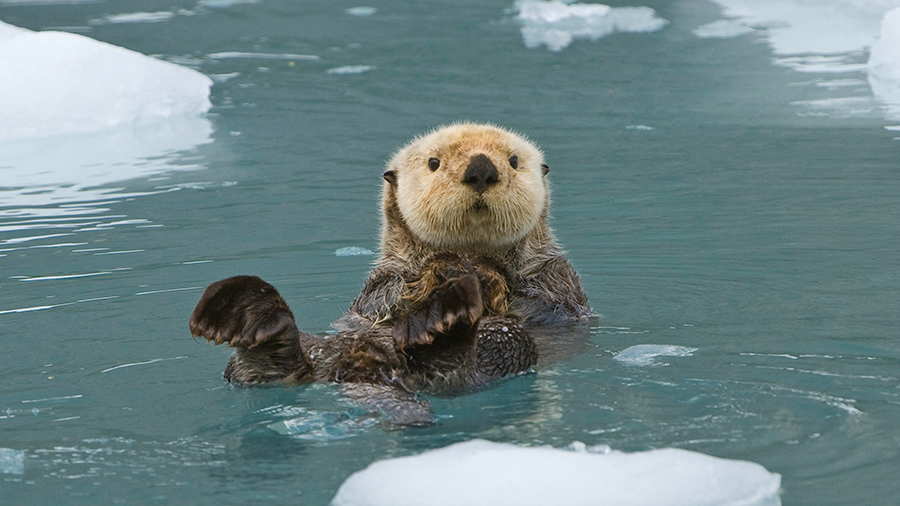Sea otters demonstrate that there is more to muscle than just movement
Life in the cold can be difficult for animals. As the body chills, organs including the brain and muscles slow down.
The body temperature of animals such as reptiles and amphibians mostly depends on the temperature of their environment – but mammals can increase their metabolism, using more energy to warm their body. This allows them to live in colder areas and stay active when temperatures drop at night or during winter months.

Although scientists know mammals can increase their metabolism in the cold, it has not been clear which organs or tissues are using this extra energy to generate more heat. Staying warm is especially challenging for small, aquatic mammals like sea otters, so we wanted to know how they have adapted to survive the cold.
We assembled a research team with expertise in both human and marine mammal metabolism, including Heidi Pearson of the University of Alaska Southeast and Mike Murray of the Monterey Bay Aquarium. Understanding energy use in animals adapted to life in the cold may also provide clues for manipulating human metabolism.
Sea otter metabolism
It is especially difficult for water-living mammals to stay warm because water conducts heat away from the body much faster than air. Most marine mammals have large bodies and a thick layer of fat or blubber for insulation.
Sea otters are the smallest of the marine mammals, and do not have this thick layer of blubber. Instead, they are insulated by the densest fur of any mammal, with as many as a million hairs per square inch. This fur, however, is high maintenance, requiring regular grooming. About 10% of a sea otter’s daily activity involves maintaining the insulating layer of air trapped in their fur.
Dense fur is not enough, by itself, to keep sea otters warm. To generate enough body heat, their metabolic rate at rest is about three times higher than that of most mammals of similar size. This high metabolic rate has a cost, though.
To obtain enough energy to fuel the high demand, sea otters must eat more than 20% of their body mass in food each day. In comparison, humans eat around 2% of their body mass – about 3 pounds (1.3 kilograms) of food per day for a 155-pound (70 kg) person.
Where does the heat come from?
When animals eat, the energy in their food cannot be used directly by cells to do work. Instead, the food is broken down into simple nutrients, such as fats and sugars. These nutrients are then transported in the blood and absorbed by cells.
Within the cell are compartments called mitochondria where nutrients are converted into ATP – a high-energy molecule that acts as the energy currency of the cell.
The process of converting nutrients into ATP is similar to how a dam turns stored water into electricity. As water flows out from the dam, it makes electricity by spinning blades connected to a generator – similar to wind turning the blades on a windmill. If the dam is leaky, some water – or stored energy – is lost and cannot be used to make electricity.
Similarly, leaky mitochondria are less efficient at making ATP from nutrients. Although the leaked energy in the mitochondria cannot be used to do work, it generates heat to warm the sea otter’s body.
All tissues in the body use energy and make heat, but some tissues are larger and more active than others. Muscle makes up 30% of the body mass of most mammals. When active, muscles consume a lot of energy and produce a lot of heat. You have undoubtedly experienced this, whether getting hot during exercise or shivering when cold.
To find out if muscle metabolism helps keep sea otters warm, we studied small muscle samples from sea otters ranging in size and age from newborn pups to adults. We placed the muscle samples in small chambers designed to monitor oxygen consumption – a measure of how much energy is used. By adding different solutions that stimulated or inhibited various metabolic processes, we determined how much energy the mitochondria could use to make ATP – and how much energy could go into heat-producing leak.
We discovered the mitochondria in sea otter muscles could be very leaky, allowing otters to turn up the heat in their muscles without physical activity or shivering. It turns out that sea otter muscle is good at being inefficient. The energy “lost” as heat while turning nutrients into movement allows them to survive the cold.
Remarkably, we found newborn pups have the same metabolic ability as adults, even though their muscles have not yet matured for swimming and diving.
Broader implications
Our research clearly demonstrates that muscle is important for more than just movement. Because muscle makes up such a large portion of body mass, even a small increase in muscle metabolism can dramatically increase how much energy an animal uses.
This has important implications for human health. If scientists discover ways to safely and reversibly increase skeletal muscle metabolism at rest, doctors could possibly use this as a tool to reduce climbing rates of obesity by increasing the amount of calories a patient can burn. Conversely, reducing skeletal muscle metabolism could conserve energy in patients suffering from cancer or other wasting diseases and could reduce food and resources needed to support astronauts on long-duration spaceflight.
Enjoy reading ASBMB Today?
Become a member to receive the print edition four times a year and the digital edition monthly.
Learn moreGet the latest from ASBMB Today
Enter your email address, and we’ll send you a weekly email with recent articles, interviews and more.
Latest in Science
Science highlights or most popular articles

Bacteriophage protein could make queso fresco safer
Researchers characterized the structure and function of PlyP100, a bacteriophage protein that shows promise as a food-safe antimicrobial for preventing Listeria monocytogenes growth in fresh cheeses.

Building the blueprint to block HIV
Wesley Sundquist will present his work on the HIV capsid and revolutionary drug, Lenacapavir, at the ASBMB Annual Meeting, March 7–10, in Maryland.

Gut microbes hijack cancer pathway in high-fat diets
Researchers at the Feinstein Institutes for Medical Research found that a high-fat diet increases ammonia-producing bacteria in the gut microbiome of mice, which in turn disrupts TGF-β signaling and promotes colorectal cancer.

Mapping fentanyl’s cellular footprint
Using a new imaging method, researchers at State University of New York at Buffalo traced fentanyl’s effects inside brain immune cells, revealing how the drug alters lipid droplets, pointing to new paths for addiction diagnostics.

Designing life’s building blocks with AI
Tanja Kortemme, a professor at the University of California, San Francisco, will discuss her research using computational biology to engineer proteins at the 2026 ASBMB Annual Meeting.

Cholesterol as a novel biomarker for Fragile X syndrome
Researchers in Quebec identified lower levels of a brain cholesterol metabolite, 24-hydroxycholesterol, in patients with fragile X syndrome, a finding that could provide a simple blood-based biomarker for understanding and managing the condition.



